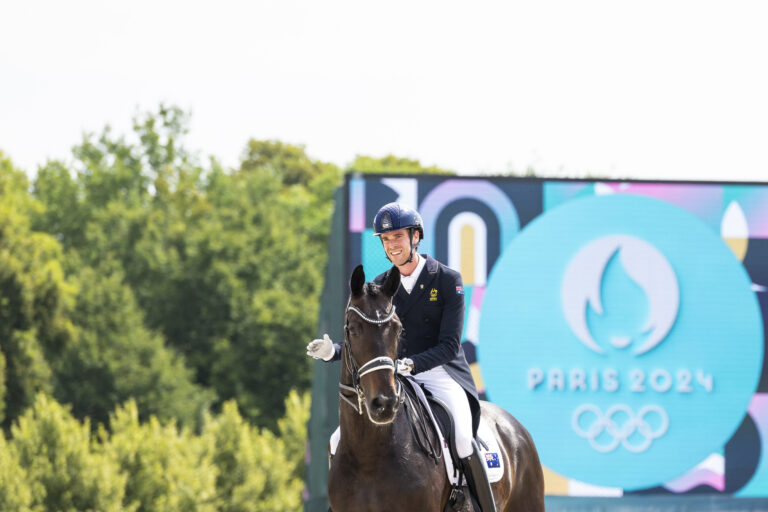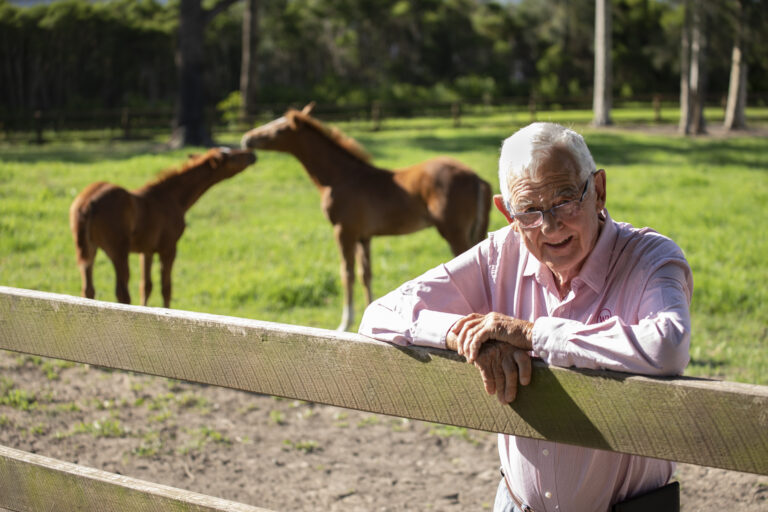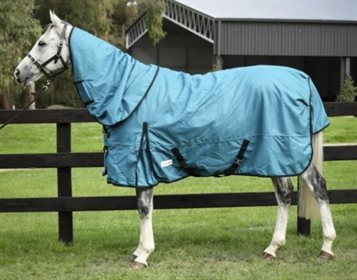This article has appeared previously with Equestrian Life. To see what is in our latest issue, please click here.
Amanda Ross & William Wordsworth.
© Jenelle Christopher
By Amanda Ross
Many of our top riders enter to win. There’s the importance of that CCI qualifier to upgrade to the next level, or the final selection trial for an Australian Team position. But, some enter just to be part of it all, to achieve their own personal goals and to say ‘I’ve completed a CCI’. If you’re in that latter category and aren’t sure how to tell whether you’re ready, lets looks at the boxes and tick them one by one.
1. Find an experienced mentor.
There’s only so much you can learn from having a riding lesson each week. Unfortunately, when it comes to managing competition horses, the riding part is only one piece of the pie. So how does the first time CCI entrant learn the ropes outside of their weekly riding lesson? Groom for, or hang out with an expert. Ask questions – how fit should my horse be/why do you feed that/what time do you feed before cross country/which arena am I allowed to ride in and when/does my horse need a passport/how fast do I run in the trot up?. The list will get longer the more you ask. Handing down information is becoming more and more like a tribal gift from the elders – so many newcomers are unaware of actually why they are doing things/wearing nosebands/boots/correct grooming – they just do it because everyone else does.
Mentors can be paid, groomed for, fed and/or given wine in exchange for information. I find offers of high standard grooming/cleaning my gear/plaiting are the definite way to gaining a verbal diarrhoea-like quantity of information from me. And from my point of view, there are very few really conscientious riders out there who appreciate the detail and dedication it takes to prepare properly, so I’m more than happy to share my experience with those who are truly keen.
2. Are you qualified?
Qualifications are put in place for a reason – to ensure both horse and rider are capable of safely taking part in the competition. And, it can be quite a confusing business. With the new ‘rider categorisation’ (are you an A, B, C or D?). Then there’s understanding what an MER is (a ‘minimum eligibility requirement’ or a ‘monotonous entry rigmarole’?). Or, figuring out whether a particular CNC counts as a qualifier and anyway, what is the difference between a CCI, CIC and a CNC? To compete in a CCI*, you generally need to have completed two CIC/CNC* events within the qualifying score boundaries. To gain a qualifying score, you must have completed the Dressage with no more than 75 penalty points (that score pretty much means you only just stay in the arena), a clear jumping round on the cross country, with a maximum of 90 seconds over/36 time fault and a Show Jumping score of no more than 16 jumping penalties/4 rails. If you are doing a 2, 3 or 4* it becomes more complex – for example, to do a CCI*** you will need a CCI** qualifying score which allows for 20 jumping penalties on the cross country, plus 2 clear CIC***’s . Confused yet?
3. Planning your season.
Ideally, a CCI is the championship at the end of each competition season, when you’ve had the chance to consolidate your performances. There are usually five to six CNC/CIC’s to run at prior to the CCI, of which you may need between three and six starts. Ideally your season plan will have you qualified early on in the piece, thus avoiding a last minute panic, which usually consists of chasing qualifiers, travelling interstate unnecessarily and backing up events weekend after weekend. Aside from wearing out your horse and bank account, there is serious pressure put on your washing machine to produce spotless whites within a four-day turnaround, especially when the winter months cover your kit in mud. Usually a minimum of two weeks between events is enough time to recover, repair, refresh and repack. The higher the level, the less runs the horse and rider should need before a CCI. They’re more experienced and the intensity is physically more taxing, so finding that balance of soundness versus ‘game ready’ is the key. Plus, if you have a setback (your horse looses a shoe on cross country and bruises his foot slightly, or the ground on cross country is horribly hard/boggy), you have the breathing space to miss an event should you already be qualified.
4. Choosing your events.
Personally, I like to travel as little as possible, to keep the horses fresher, save on fuel and support local events. There are, however a few key events I like to enter, to see where I’m at against the best competition – Albury CIC is a great event to let me know where I sit in the pecking order. There’s no point entering only the easy events, or entering a CCI with minimum level of experience. Exposure is the key. Plan to train and compete over a variety of terrains and fences and be mindful of the type of course your CCI will present – Melbourne is very flat, whereas Sydney has some decent hills, so you will need to know your horse is fit and controllable for the job ahead. And the big thing to remember – your last start is ideally two to three weeks before the CCI. Too much time between starts can leave you lacking competition savvy, whereas leaving your last start too late can leave your horse with a bump, cut or sore back/mouth one week out from a CCI to create absolute havoc, make you completely freak out and buy more vet products and last minute miracle cures than an insomniac pharmacist with an online shopping addiction.
Lets say you’ve ticked all the above boxes – qualified, experienced and prepared. And, now to the entries. Wow, so many forms to fill in, so much money to fork out. Competing in a CCI isn’t cheap, so be prepared. Class entry fees, stabling for the week, a powered camping site, shavings, welcome/after party tickets, admin/medical levies, petrol, food and of course the trot-up outfit. There’s in excess of $1000 immediately. Plus the week off work and away from home – although this could be considered a holiday by some. Then the fun begins…
5. Arriving at the event.
You must read all the event info before you leave home. There are set days and times you need to arrive, because the first thing you do is take your horse, with its papers, to the vet health clearance and ID check. You can’t take your horse into the stables until this is done, so plan your arrival within these times, and don’t forget your papers. Follow the instructions from all lanyard wearing, tweed coated, hi-viz clad officials – if you ignore the rules they will chase you down and tell you off, like a junior school headmaster, making you feel about 10 years old. Wear your bridle number/wrist pass all the time, don’t ride in the wrong place and don’t get caught climbing over or making a gap in the security fence, so you don’t have to walk the long way round.
6. Claiming your stakes.
Arranging your float/truck/caravan on the ideal angle, with room for the awning, setting up your tackroom/stable/feed, plugging into the right power point and meeting your new neighbours for the week needs to be given careful consideration. Sleeping with your head downhill will result in some bad bed hair wakeups, and if it rains and you forget a tarp, your feed and hay may get very wet. It is also worth remembering, that winter CCI’s = cold weather = 250 heaters turned on at 5pm = power blowout. The amount of times I have legged it to the power box to switch the trip meter back on is unfathomable. Tip: take an emergency generator.
7. Planning your day.
After reading your event info, picking up your ‘showbag’ from the secretary’s office, reading the daily schedules and attending the riders meetings, it’s essential to plan the day’s activities. There are certain arena’s, gallop areas, jumping areas and times to use each. You may find everyone wants to ride at the same time and there’s a queue to get into an arena. Wash bays will block and everyone will be shampooing before the trot up – allow plenty of time. Make sure you have someone to help you (see ‘groom’) just so everything stays relaxed and you can concentrate on riding well. My suggestion is to write your times on a whiteboard the evening before and discuss with your groom, add notes for jobs to be done and tick them off as you go.
8. Finding your groove.
The first time CCI rookie may feel a little overwhelmed by sharing an arena with Shane Rose, but at the end of the day, just do your thing. Use the experience to observe the grooms at the stables, take time to watch riders warm up, look at their tack, take it all in. But most importantly, you qualified, you earned your place in the class, so don’t lose direction and start panicking just because the pressure is on. Organise your trainer to come and give a lesson and warm you up before your test; ask to walk the course with your trainer, or a more experienced rider in your class. Plan ahead so you enjoy the event and give yourself the best chance of success.
These days, CCI’s are so much less of a stress due to the absence of the roads and tracks and steeplechase. Today’s CCI is really just a longer, chunkier CIC, with a few more fancy formal occasions to attend. A couple of my good friends and clients have volunteered to groom at CCI’s for me, in order to experience the event on foot, before tackling it one day themselves. This is a great idea, it really prepares you for what to expect.
READ THE LATEST NEWS ARTICLES HERE







